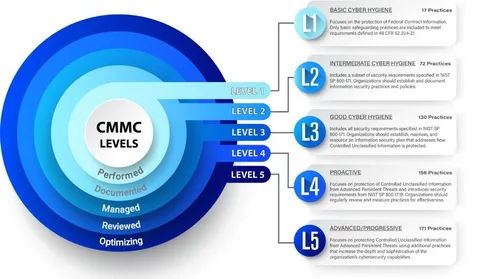Conversations around cybersecurity often lead back to one key question: how can companies prove that their defenses actually work? For defense contractors under the Cybersecurity Maturity Model Certification (CMMC), penetration tests appear as a tool many already recognize, but not everyone is clear on whether these tests match the baseline expectations of CMMC level 1 requirements. This discussion takes a closer look at how penetration testing interacts with the specific items in CMMC checklists, while also showing where higher levels such as CMMC level 2 compliance might demand more structured proof.
Verification of Boundary Protections Against Unauthorized Access
Boundary protections remain a priority for any organization subject to CMMC compliance requirements. CMMC level 1 requirements call for measures that stop unauthorized users from accessing internal systems. Penetration tests examine these boundaries by simulating how attackers attempt to bypass firewalls, routers, and intrusion detection tools. This evaluation gives companies a clear picture of whether their safeguards perform as intended under pressure.
Beyond that initial layer, penetration testers assess how well boundary protections are configured and maintained. A C3PAO reviewing results from these tests will want to see not just the technology in place but evidence that settings actively enforce the rules required by CMMC compliance requirements. For companies aiming for CMMC level 2 compliance, boundary testing takes on added weight because higher levels of certification emphasize a structured approach to managing risks.
Assessment of Account Controls Within User Authentication Practices
User authentication controls are often underestimated until a breach reveals weaknesses. Penetration testing helps validate whether accounts enforce strong password policies, multifactor authentication, and role-based restrictions. These align directly with CMMC level 1 requirements, which focus on controlling system access to authorized individuals only.
A personal audit may uncover inconsistencies, but a simulated attack goes further by showing how easily an attacker might exploit poor account hygiene. Results often highlight whether privileged accounts are too abundant or improperly monitored. As organizations pursue higher standards like CMMC level 2 requirements, strengthening account controls becomes an essential step before certification by a CMMC RPO or C3PAO.
Confirmation of Encrypted Channels for Data Transmission Pathways
Data in transit is another checkpoint on the CMMC compliance requirements checklist. Penetration testing confirms whether sensitive data uses encrypted channels, such as TLS or VPN tunnels, when moving between systems. CMMC level 1 requirements stress basic encryption practices, and penetration tests validate that encryption is enforced consistently, not just assumed.
Weak encryption or misconfigured certificates often emerge during penetration testing. These flaws, though technical, have direct consequences for CMMC level 2 compliance because auditors expect clear proof that secure pathways are the default. Penetration testers document these findings, offering organizations a chance to correct weaknesses before assessment by an official C3PAO.
Review of Physical and Logical Access Points to Sensitive Systems
Penetration tests extend beyond virtual environments into physical and logical access points. Testers may evaluate whether data centers have appropriate entry restrictions or whether remote access gateways are vulnerable. CMMC level 1 requirements mention limiting access to authorized users, and penetration tests show how these principles apply in practical scenarios.
For contractors moving toward CMMC level 2 requirements, physical and logical access reviews demonstrate how comprehensive security measures must be. A CMMC RPO may advise combining penetration testing with policy audits to ensure that both people and technology follow established security protocols. These findings connect directly to compliance readiness and long-term resilience.
Evaluation of Incident Identification Through Simulated Attack Vectors
CMMC compliance requirements highlight the need for identifying incidents when they occur. Penetration tests play a role here by simulating attack vectors to see whether detection systems respond. While CMMC level 1 requirements only expect basic practices, such as recognizing unusual activity, penetration tests reveal whether monitoring tools detect and log those attempts.
The outcomes of these tests often show gaps in real-time visibility. For organizations seeking CMMC level 2 compliance, the results become even more significant. Incident response capability needs documented evidence, and penetration testing provides a form of validation that both internal teams and C3PAOs recognize during formal assessments.
Documentation of Remediation Effectiveness in Addressing Detected Flaws
Fixing problems matters as much as finding them. Penetration testers revisit systems after remediation to confirm that patches or new controls actually work. This loop of testing and re-testing connects directly with the expectations of CMMC compliance requirements, particularly when contractors prepare for reviews under CMMC level 2 requirements.
A CMMC RPO often stresses the importance of maintaining records of remediation. Documentation not only proves compliance but also demonstrates a company’s commitment to continual improvement. For CMMC level 1 requirements, this step may appear optional, yet it sets a strong foundation for meeting higher standards in future audits.
Validation of Logging and Accountability Measures in Restricted Environments
Accountability depends on accurate logging of activity across systems. Penetration tests validate whether attempted breaches and user actions are recorded in a way that aligns with CMMC compliance requirements. At the CMMC level 1 requirements stage, this might involve confirming that logs exist and are reviewed periodically.
As the bar rises toward CMMC level 2 compliance, validation expands to include monitoring restricted environments in detail. Penetration testers highlight missing logs or failures to alert administrators. These insights are essential during a C3PAO assessment because they prove whether accountability measures function in practice, not just on paper.
Measurement of Resilience in Basic Security Configurations Across Endpoints
Endpoints form the largest attack surface for any contractor. Penetration tests measure how resilient these devices are under simulated attacks, revealing whether baseline configurations meet the CMMC level 1 requirements. Simple checks, like verifying antivirus protections or patching schedules, often surface weaknesses that attackers could exploit.
The broader perspective comes with CMMC level 2 requirements, where endpoint security ties into organizational resilience. A CMMC RPO may advise continuous monitoring of endpoint configurations and periodic penetration testing to verify improvements. These measurements help ensure that basic protections remain strong, even as threats evolve, and prepare companies for higher-level certification demands.




